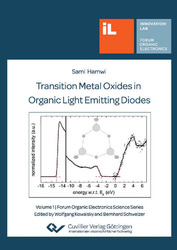| Fachbereiche | |
|---|---|
| Buchreihen (96) |
1378
|
| Nachhaltigkeit |
3
|
| Gesundheitswesen |
1
|
| Geisteswissenschaften |
2364
|
| Naturwissenschaften |
5406
|
| Mathematik | 229 |
| Informatik | 319 |
| Physik | 980 |
| Chemie | 1363 |
| Geowissenschaften | 131 |
| Humanmedizin | 243 |
| Zahn-, Mund- und Kieferheilkunde | 10 |
| Veterinärmedizin | 108 |
| Pharmazie | 147 |
| Biologie | 835 |
| Biochemie, Molekularbiologie, Gentechnologie | 121 |
| Biophysik | 25 |
| Ernährungs- und Haushaltswissenschaften | 45 |
| Land- und Agrarwissenschaften | 1004 |
| Forstwissenschaften | 201 |
| Gartenbauwissenschaft | 20 |
| Umweltforschung, Ökologie und Landespflege | 148 |
| Ingenieurwissenschaften |
1793
|
| Allgemein |
98
|
|
Leitlinien Unfallchirurgie
5. Auflage bestellen |
|
Erweiterte Suche
Transition Metal Oxides in Organic Light Emitting Diodes (Band 1)
Sami Hamwi (Autor)Vorschau
Inhaltsverzeichnis, Datei (62 KB)
Vorwort, Datei (29 KB)
Leseprobe, Datei (1,5 MB)
Organic light emitting diodes (OLEDs) exhibit several specific properties such as an extremely thin design and a wide viewing angle, making them favorable for the application in display technology and general lighting. The development of OLEDs is strongly driven by the prospect of low-cost production of largearea applications in the future. Accordingly, their performance was considerably enhanced in terms of efficiency and lifetime over the past years. The introduction of transition metal oxides (TMOs) in OLEDs is regarded as a promising concept for further improving their properties due to their technological compatibility with organic layers and their high thermal stability. The first results from the insertion of TMOs in OLEDs indicate their versatile application as neat functional layers and electrochemical dopants of organic semiconductors. On the other hand, the knowledge of their electronic properties and the mode of operation in OLEDs is very limited so far. In this context, it becomes apparent that fundamental mechanisms such as the electrochemical doping of organic semiconductors or the charge generation in interconnecting units of stacked OLEDs are not yet completely clarified.
Thus, this work focuses on the physical and technological correlations arising from the application of transition metal oxides in organic light emitting diodes. First, the electronic structure of molybdenum oxide (MoO3) and tungsten oxide (WO3) is analyzed by photoelectron spectroscopy and Kelvin probe. It is demonstrated that both TMOs exhibit comparably deep-lying energy levels. Moreover, their electronic structure indicates them as intrinsically n-doped semiconductors. The functional principle of the efficient hole injection by neat layers of TMO is then studied by the examination of the interfaces between the TMO and its adjacent layers. As a result, a new model of hole injection by thin TMO layers is developed.
The concept of electrochemical doping in OLEDs represents a very important technique to improve their overall efficiency. For that reason, the suitability of MoO3 as p-type dopant and Cs2CO3 (cesium carbonate) as n-type dopant of organic wide band gap semiconductors is studied,respectively. First, the impact of electrochemical doping on the electrical, optical and morphological properties is analyzed. The focus, however, is on the determination of the doping concentration dependent charge carrier densities. Measurement techniques, known from the world of inorganic semiconductors, such as capacitance voltage measurements on metal-insulator-semiconductor structures or the direct analysis of the space charge regionin doped semiconductors at the metallic electrode are applied for the determination of the densities and compared with each other. The study reveals an approximately linear increase of the charge carrier density with higher doping concentrations as a general result. At the same time, the doping efficiency of MoO3 is unexpectedly low and under five percent on average.
The stacking of several light emitting units on top of each other is known to increase the lifetime of organic devices. Therefore, it is important to reveal the functional principle of the charge generation layers (CGL) as the interconnecting units of the stacked OLEDs. Besides the analysis of a complementarily doped homojunction-CGL, the role of neat layers of TMO in CGLs is investigated. The mechanism of charge generation between doped layers is explained by the formation of a space charge region. On the other hand, it is demonstrated that the actual charge generation in interconnecting units using transition metal oxides occurs at the interface between the TMO and the adjacent hole transporting layer. Finally, the investigations of the physical aspects in this work allowed for the realization of the first organic p-i-n homojunction device which operates both as violet light emitting diode and visible blind photodiode.
| ISBN-13 (Printausgabe) | 3869554843 |
| ISBN-13 (Printausgabe) | 9783869554846 |
| ISBN-13 (E-Book) | 9783736934849 |
| Sprache | Englisch |
| Seitenanzahl | 170 |
| Auflage | 1 Aufl. |
| Buchreihe | Forum Organic Electronics Science |
| Band | 1 |
| Erscheinungsort | Göttingen |
| Promotionsort | TU Braunschweig |
| Erscheinungsdatum | 15.10.2010 |
| Allgemeine Einordnung | Dissertation |
| Fachbereiche |
Physik
|








